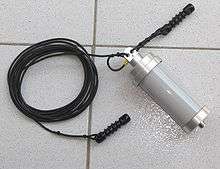Random wire antenna
A random wire antenna is a radio antenna consisting of a long wire suspended above the ground, whose length does not bear a relation to the wavelength of the radio waves used, but is typically chosen more for convenience. The wire may be straight or it may be strung back and forth between trees or walls just to get enough wire into the air. Such antennas are usually not as effective as antennas whose length is adjusted to resonate at the wavelength to be used. Random wire antennas are a type of monopole antenna and the other side of the receiver or transmitter antenna terminal must be connected to an earth ground.

They are widely used as receiving antennas on the long wave, medium wave, and short wave bands, as well as transmitting antennas on these bands for small outdoor, temporary or emergency transmitting stations, as well as in situations where more permanent antennas cannot be installed.
Random wire and long wire
Often random wire antennas are also (inaccurately) referred to as long-wire antenna. Long-wire antennas require a length greater than a quarter-wavelength (λ/4) or half (λ/2) of the radio waves (most consider a true long wire to be least one wavelength[1]), whereas random wire antennas have no such constraint.[2]
However, problems can occur when the length of the so-called random wire happens to be a multiple of half-wavelengths on the transmitting frequency (odd multiples of the quarter wavelength do not have this problem). This reduces the efficiency of the antenna, and should be avoided. For the Amateur radio HF bands, operator W0IPL developed a table of usable odd multiple lengths, and then down-selected these to pick an ideal work-any-band length of 74 feet (22.56 m).[3]
Radiation pattern
The radiation pattern of a straight random wire antenna is unpredictable and depends on its electrical length; its length measured in wavelengths (λ) of the radio waves used. The radiation will drop off to zero on the axis; however it may have several lobes (maxima) at angles to the antenna axis.[4] Under about 0.6λ a wire antenna will have a single lobe with a maximum at right angles to the axis. Above this the lobe will split into two conical lobes with their maximum directed at equal angles to the wire, and a null between them. This results in four azimuth angles at which the gain is maximum. As the length of wire in wavelengths increases, the number of lobes increases and the maxima become increasingly sharp. The above applies to random wires in space; the presence of the ground modifies the radiation pattern, a long wire antenna close to the ground will also act somewhat as a traveling wave antenna and have reception off the end of the wire. A folded or zig-zag antenna will exhibit a pattern that is even more complicated and difficult to predict.
Long wire antennas are reported to be more effective for reception than multielement antennas such as Yagi or quad antennas with the same length of wire.
Construction

A random wire antenna usually consists of a long (at least one quarter wavelength) wire with one end connected to the radio and the other in free space, arranged in any way most convenient for the space available. Ideally, it is a straight wire strung as high as possible between trees or buildings, the ends insulated from supports with strain insulators. Typically it is made from number 12 or 14 AWG (1.6 to 2.0 mm (0.063 to 0.079 in) diameter) copperclad wire. Folding the wire into a zigzag pattern to fit in a limited space such as an apartment or attic will reduce effectiveness and make theoretical analysis extremely difficult. (The added length helps more than the folding typically hurts.)
If used for transmitting, a random wire antenna usually will also require an antenna tuner, as it has an unpredictable impedance that varies with frequency.[1] One side of the output of the tuner is connected directly to the antenna, without a transmission line, the other to a good earth ground. A quarter-wavelength sized wire works best, and unless fed through an unun, a half-wavelength will exceed the matching ability of most tuners.[5][6] Even without a good earth, the antenna will also radiate, but it will do so by coupling capacitively to any nearby conducting material; this is not recommended.[7] The ground for a random wire antenna may be chosen by experimentation. Grounds could be returned to a nearby cold water pipe or a wire approximately one-quarter wavelength long, or can be replaced by randomly laid-out quarter-wavelength counterpoise wires attached to the ground connection.[1]
References
- Straw, R. Dean (2003). The ARRL Antenna Book, 20th Edition. Newington, Connecticut, USA: The ARRL, Inc. p. 944. ISBN 0-87259-904-3.
- Practical Antenna Handbook (Carr, Mc Graw Hill) - Chapter 9
- ""Random" Length - Wire Antennas WØIPL".
- Silver, Ward (2007). The ARRL General Class License Manual, 6th Ed. USA: American Radio Relay League. p. 6.6. ISBN 978-0872599963.
- The "Almost Random" Wire Antenna
- Random length wire
- The End Fed Half Wave Antenna (Steve Yates, AA5TB) http://www.aa5tb.com/efha.html